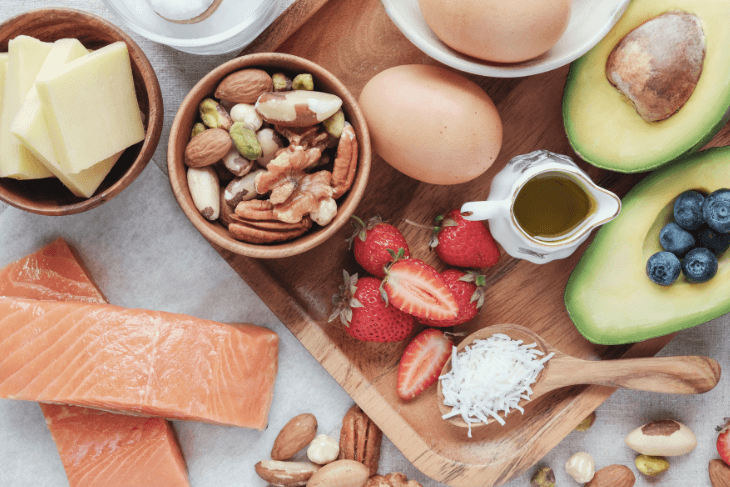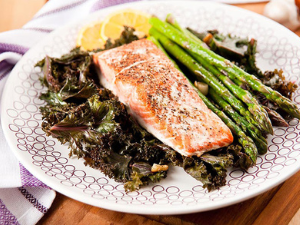CSIRO Total Wellbeing Diet vs the keto diet

The ketogenic diet, or keto diet, is a very-low-carbohydrate, high-fat diet. The diet has been around for over a century, and was originally created as a treatment for severe epilepsy in children. Over the years, keto has gained popularity as a weight loss method, with proponents claiming that it will not only help you lose weight quickly, but it can even reverse type 2 diabetes.
Keep reading to see if these claims really stack up, and how keto compares to the CSIRO Total Wellbeing Diet.
How does the keto diet work?
The keto diet is a very-low-carbohydrate, moderate-protein and high-fat style of eating. On average, your daily kilojoule (calorie) intake should come from: 55 to 60 percent fat, 30 to 35 percent protein and five to 10 percent carbs.
Keto works by switching your body’s primary fuel source from glucose to fat. When you restrict carbs in your diet, your body runs out of glucose to use for energy. It will then start using an alternative fuel, called ‘ketones’, which are made from stored fat. This process is called ‘ketosis’.
What can you eat on the keto diet?
Foods that are high in fat are the stars of the keto diet. Plates are typically loaded up with eggs, fish, plant oils, nuts, seeds, avocado, meat, butter and cheese!
But what about fruits and veggies? You might be wondering where they fit into a keto diet.
On keto, you can eat some low-carb, non-starchy veggies (think leafy greens, broccoli, onion, mushrooms, cucumber). But when it comes to fruit, your choices are pretty much limited to berries, which are low in carbs.
What can you not eat on the keto diet?
If you’re following the keto diet, forget pasta, rice, bread and noodles. Foods like beans and legumes are no-go zones too, as well as veggies like potato, sweet potato, corn and beetroot.
And while dairy milk delivers fat, it’s not necessarily keto-friendly. This is because, like fruit, it contains natural sugars.
Looking for weight loss motivation, dinner inspiration or exercise ideas? Check out the CSIRO Total Wellbeing Diet blog or take a look at some of our delicious, healthy recipes.
Can you lose weight on the keto diet?
Research behind the keto diet shows that it is an effective way to lose weight. One of the reasons behind this could be because the high level of fat in the diet keeps you feeling full.
Studies also show that keto can also be an effective treatment for type 2 diabetes, with a 2021 study showing that participants who underwent a very-low-calorie keto diet, followed by a slow reintroduction of carbohydrates, were able to reduce or completely stop taking diabetes medication after 12 months.
What are some of keto’s drawbacks?
Like most diets that are based on restriction, one of keto’s biggest drawbacks as a weight loss diet is your ability to ‘stick’ with it. Cutting out, or severely reducing carbs, from your diet might lead to weight loss in the short term, but it leaves no room for long-term flexibility. Indulging in a few biscuits with your coffee, having an extra piece of toast at breakfast or a slice of pizza for dinner could take your body out of ketosis, and potentially reverse any progress you’ve made on the diet.
Another issue with the diet is that by cutting out or restricting certain foods, you may miss out on some essential nutrients. Wholegrains, beans, legumes, vegetables and fruit are vital sources of fibre, as well as various antioxidants, vitamins and minerals that your body needs to thrive.
CSIRO Total Wellbeing Diet vs the keto diet
Where keto is very-low-carb, moderate-protein and high-fat, the CSIRO Total Wellbeing Diet follows a higher-protein, moderate-fat and moderate-carb (low GI) eating style.
The balance of food groups in the CSIRO Total Wellbeing Diet helps you lose weight by keeping you feeling full for longer. Plus, by including all food groups, you get all the essential nutrients you need for optimal health.
On the CSIRO Total Wellbeing Diet, low GI carbs are your friend. Foods like wholegrain bread, noodles, oats, legumes and beans provide vital nutrients while keeping your energy levels even and balanced, and your gut happy.
One of the biggest benefits of the CSIRO Total Wellbeing Diet is that Indulgences are built into the program; you can have your cookies, pizza, cake, wine or whatever else you enjoy as a treat, without undoing any of your healthy habits.
The CSIRO Total Wellbeing Diet is a sustainable way of eating and keeping weight off long-term; it’s easier to stick to a ‘diet’ when nothing is restricted.
CSIRO Total Wellbeing Diet for type 2 diabetes
Members who have lost weight with the CSIRO Total Wellbeing Diet also experience a range of health benefits – and top of the list is improvements to their type 2 diabetes. In a recent survey of CSIRO Total Wellbeing Diet members, 81 percent of those who lost the most weight saw an improvement in their type 2 diabetes, while nearly 60 percent of the total sample saw improvements in their pre-diabetes.
Developed in partnership with Diabetes NSW, CSIRO Total Wellbeing Diet has developed the Special Edition for Pre-diabetes and Type 2 Diabetes Program. The special edition program features simple carbohydrate-controlled meals and additional educational content around diet and blood glucose levels.
Are you trying to lose weight? Read our comprehensive guide on weight loss to understand where to begin, what happens when you lose weight, and what doesn't work when it comes to dieting.


